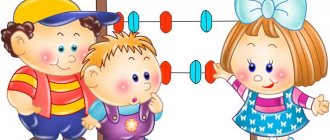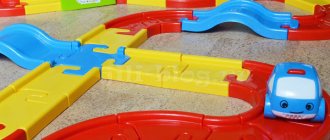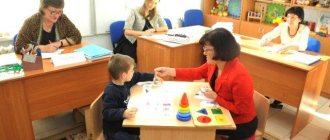Library of the program of education and training in kindergarten
under the general editorship of M. A. Vasilyeva, V. V. Gerbova, T. S. Komarova
The program “Development of Young Children in Kindergarten” is published based on the text of the book “Program of Education and Training in Kindergarten” edited by M. A. Vasilyeva, V. V. Gerbova, T. S. Komarova.
Authors:
S. N. Teplyuk;
G. M. Lyamina (“Peculiarities of development of young children”);
M. B. Zatsepina (“Musical education”, “Entertainment games”, “Musical games, entertainment and holidays”).
Preface
This publication is part of the methodological set for the “Program of education and training in kindergarten” (edited by M. A. Vasilyeva, V. V. Gerbova, T. S. Komarova. - 4th ed., revised and supplemented - M.: Mozaika-Sintez, 2007), which, in accordance with modern tasks of preschool education, provides for the comprehensive development of the child based on his age-related capabilities and individual abilities.
The leading goals of the “Program” are the creation of favorable conditions for a child to fully enjoy preschool childhood, the formation of the foundations of basic personal culture, the development of mental and physical qualities, and the preparation of a child for life in modern society and for school.
The “Program” is recommended by the Ministry of Education and Science of the Russian Federation for preschool education institutions.
Brief “Methodological Recommendations” have been prepared for the “Program” (M.: Publishing House “Education of the Preschooler”, 2005; M.: Mozaika-Sintez, 2007), revealing the features of the organization and methods of work in all main sections of the upbringing, training and development of a child in kindergarten at different age stages of preschool childhood.
More detailed methodological guidelines for the “Program” are contained in the methodological manuals: Komarova T. S. “Visual activities in kindergarten” (M.: Mozaika-Sintez), Gerbova V. V. “Speech development in kindergarten” (M.: Mosaika-Sintez), M. B. Zatsepina “Musical education in kindergarten” (M.: Mozaika-Sintez), etc.
The manual “Early Children in Kindergarten” continues the series of publications of this educational and methodological set. The book includes a program and methodological recommendations for raising and teaching young children. In each age group, general and special tasks of their development are identified, and methods for solving them are presented.
MAGAZINE Preschooler.RF
Article on the topic: “Development and education of young children in preschool educational institutions according to the requirements of the Federal State Educational Standard”Sharenko Vera Alexandrovna. MBDOU "Kindergarten "Varenka" , Abakan city, teacher.
Early childhood is a special time for the development of children's bodies. Almost all mechanisms in the cerebral cortex do not depend on heredity, but develop directly as a result of the body’s contact with the surrounding reality. This happens especially noticeably in the first three years of life, so it is important to lay the prerequisites for the healthy development of the child in a timely manner.
Professor N.A. Aksarina, being the founder of a nursery, in our country for the first time formed a complex of characteristics of the development of children in early childhood. She argued that the child's body develops at a rapid pace. In no other time period of childhood can such a rapid increase in the mass and length of the child’s body and the development of all brain functions be observed. The rapid pace of formation of a child’s body has its own characteristics. Directly, first of all, this is a spasmodic development. Critical moments in human development - 1 year, 2 years, 3 years, 6-7 years, 12-13 years. It is during these time periods that dramatic changes occur in the formation of new qualities in child development: 1 year is the time of mastering walking; 2 years - the formation of visually effective thinking, a turning point in the development of speech skills; 3 years is a period of clear connection between the child’s behavior and development and the second signaling system, the formation of personal development; 6 - 7 years - the period of maturity for schooling; 12-13 years – puberty, development of gender characteristics of this age. [2; 165].
Spasmodicity reflects the natural, reasonable course of a child’s development. If there are no developmental leaps, then this is a sign of defects in the baby’s development. Consequently, it is very important, while the child is enriching the experience of existence in society, to create effective conditions for the timely formation of a new quality in the development of various functions. It is very important to understand that critical periods involve the child overcoming enormous difficulties and can go in parallel with a decrease in the performance of children and other disorders of the functions of the child’s body. Good care that spares the child’s nervous system, care, and attention help him overcome all the difficulties of this period.
The pace of a child’s development depends on the rapid establishment of connections with the outside world and the slow consolidation of reactions. The skills and abilities of young children are characterized by an unstable and incomplete nature. In this regard, in teaching children it is necessary to use repetition of the material covered, to ensure a connection between the child’s independent work and the adults around him.
Spasmodic development of a young child depends on the maturation of many functions within a certain time frame. N.M. Shchelovanov and N.M. Aksarina, observing this pattern, identified the leading lines in the development of the child, based on the periods in which the baby’s special sensitivity to certain types of influences can be traced. They noted that when raising children, special attention should be paid to the formation of those reactions that mature again or directly for the first time and which cannot be formed independently, without any purposeful actions of an adult. For example, the “revival complex” , which is inherent in a baby at 3 months, the ability to use simple sentences in a conversation with an adult at 2 years, the appearance of role-playing games at 3 years.
Due to the rapid pace of development of the body, a child under 3 years of age is characterized by great vulnerability and lability of his internal state. At this age, the baby is susceptible to frequent and sudden illnesses, his emotional state changes dramatically, he gets tired easily, and his nervous system is unstable.
The foundation in teaching young children is the development of a number of abilities: imitation, reproduction, observation skills and the ability to listen, compare, analyze, distinguish, contrast, synthesize life experience.
Another feature of early age is the interdependence of the health, physical and neuropsychic state of children. A strong, physically healthy child is much less susceptible to illness and develops better mentally. But we should not forget that even minor disturbances in the baby’s well-being have a negative impact on his emotional sphere and behavior.
Every healthy child in the first three years of his existence has a high degree of indicative reactions to everything around him. This age-related feature directly activates the needs for sensorimotor development. Science has proven that if children are limited in enriching information and processing it, then in accordance with their age capabilities, the pace of their development slows down. Sensory needs are the basis for the baby’s high motor activity, and movement is a natural, conditioned state of the child, which is responsible for the development of his intellect and personal development in the future.
A special place in early childhood is given to the child’s emotions, which directly arise during routine moments - feeding, keeping the child awake, and shaping behavior. Emotions ensure the comprehensive development of a child’s personality. Positive emotions that arise when interacting and communicating with adults and peers are the key to the formation of a fully developed child’s personality.
The leading role in the development of a young child belongs to an adult. Its function is to provide all the conditions that are necessary for the development of a positive state of health for the child. When communicating with a child, an adult gives warmth, affection, and provides the volume and content of information that will be useful for the development of the child’s mind and inner state of soul. A friendly attitude, calmness, understanding, and sympathy are the key to a balanced state of the baby.
In the upbringing of young children, the unity of influence of all participants in the educational process should prevail: teachers, parents and other close family members. This is one of the conditions that ensures the child’s full, all-round development and well-being. In a family, a child is often given attention and raised by several people: mother, father, grandmother, grandfather and other adults - and their actions are not always coordinated or inconsistent in their demands on the child. Consequently, in these cases, the baby cannot orient himself in the correctness of his behavior and does not understand how exactly to behave in various situations. Some children do not obey the demands and requests of an adult, others, stronger ones, try to adapt to the situation that has arisen, each time changing their opinion and behavior, which is the most difficult task for them. A child, trying to please each side, causes great harm to his mental health. That is why adults themselves often become the cause of a child’s unbalanced, aggressive behavior. Therefore, it is important to know and understand that the requirements must be consistent and equally feasible for the baby. [5; 112].
When a teacher admits a child to kindergarten for the first time, he should know as much information as possible about him. Frequent conversations with parents and doctors add to the general understanding of the child; the teacher has the opportunity to more correctly organize interaction with each of the students, which has a positive effect on the development of each of them. You should not sharply adjust the baby’s habits, because everything should happen harmoniously, gradually, the teacher should show maximum patience with each of his pupils.
Young children are incredibly suggestible and easy to manipulate. Directly when communicating, they convey the mood of the people around them. An increased, sudden, irritable tone, sudden transitions from affection to rudeness, shouting negatively affect the baby’s behavior.
You should use prohibitions when raising children very carefully and meaningfully. After all, frequent prohibitions, as well as frequent permission to do whatever you want, are harmful to the extreme. In one case, children always restrain themselves, in the other, they do not develop the skills necessary for life. Prohibitions must be justified, demands must be made in a balanced, friendly, calm voice. The requirements must be feasible for the child to fulfill.
Independence is formed in children from early childhood. A child’s performance of actions without the help of an adult gives him special pleasure very early on. Having barely learned to speak, the child often uses the following statement in his speech: “I myself . This baby’s need for activity, independence, and self-affirmation should be supported by any means. Let the child try to perform the actions independently. This is one of the conditions for the successful development of skills and good mood of the baby. [1; 9].
Very often, the cause of restless behavior in children is disruption of his activities, intrusion into his comfort zone. A child at an early age is not able to abruptly, voluntarily finish one type of activity and immediately begin to engage in another type; the requirement to immediately stop the activity and do something else is beyond his strength, causing him to be sharply indignant and protest against the adult.
During the educational process, it is necessary to take into account the individual characteristics of each child. All children have a different type of nervous system and, therefore, the limit of their working capacity is not the same: some of them are very hardy, while others get tired very quickly.
Children's behavior is also influenced by the organization of the child's activities. If this activity is organized incorrectly, it often becomes the cause of inappropriate behavior of the child. Dissatisfaction and lack of physical activity lead to a lack of impressions and life experience in communicating with adults and peers. Therefore, strict adherence to the baby’s daily routine is the key to developing adequate child behavior.
Taking into account the characteristics of the early childhood period, a number of tasks and means of raising a child as a full-fledged, comprehensively developed personality are identified.
Objectives in physical education: protection and promotion of children's health; full physical and mental development; instilling and consolidating cultural and hygienic skills. Basic means of education: intensification of hardening activities; wide and frequent use of air, sun and of course water; rational nutrition taking into account regime moments, general massage, gymnastics; compliance with the baby's daily routine; ensuring sufficient movement of the child.
Objectives of mental education: development of actions with surrounding objects; sensorimotor development; baby's speech development; development of games and other activities; formation of basic mental processes (attention, memory, imagination, etc.); development of mental abilities and consolidation of skills in practice; formation of needs in the cognitive sphere. The main means of education: business and partnership communication between an adult and a child during his independent activities and games; creating a social development situation through various types of activities; consolidation of skills in the child’s independent activities in everyday life, in games, in communication.
The objectives of moral education include the following: the formation of a respectful, friendly relationship with adults; nurturing positive personality traits; fostering positive interactions with friends; education and consolidation of positive habits; training in basic prerequisites for work. Means of moral education: patterns of adult behavior; approval of good deeds, encouragement, praise.
Objectives of aesthetic education: developing the skills to see beauty in the surrounding world, nature, people; development of creative abilities and talent. The tasks of education are solved in different ways and means: through contact with nature, music, when teaching aspects of singing, modeling, drawing, reading folk tales and stories.
All of the above tasks are solved directly through the joint efforts of the preschool institution and the child’s family. Many parents show a high interest in pedagogical knowledge, realizing that ignorance of the principles of education, the characteristics of the morphological maturation of the child’s body and the state of his health can lead to an erroneous interpretation of methods in pedagogy, to the emergence of any non-existent, unreasonably adjusted hardening techniques, improper organization of childcare baby. Therefore, the job responsibilities of the educator include directly working with parents to educate them in the field of pedagogical knowledge, and, in case of special need, directing and correcting their actions in the educational process of their child.
In conclusion of this article, we can conclude that the main role in the development of a young child is played by an adult who directly interacts with him in everyday life, and the psychological and physical development of the child in a given period depends on how professionally this activity is organized. age.
Literature
- Aksarina N.V. Raising young children. M., Medicine, 2017.
- Vygotsky L. S. Thinking and speech // Collection. Works: In 6 vols. M., 2016 T. 2.
- Davydov V.V. Problems of developmental training. M., 2017
- Leontyev A. N. Problems of mental development. M., 2022.
- Lisina M.I. Age and individual characteristics of communication with adults in children from birth to 7 years. M., 2022.
- Raising and teaching children in kindergarten / Ed. A. V. Zaporozhets, T. A. Markova, M., Pedagogy 2022.
| Next > |
Program
Features of development of young children
The first group of young children (from birth to one year)
The first year of a child’s life in terms of development is valuable in itself, both in itself and from the perspective of a long-term perspective. But pedagogical influences will achieve the goal only if the peculiarities of its development are known.
This period of a child’s life is characterized by a faster pace of physical, mental and even social development than ever before.
The average weight (body weight) at birth is 3200–3400 g. By 5–6 months it doubles, and by one year it triples. The average height of a child at birth is 50–52 cm; by the age of one year the baby grows by 20–25 cm.
Adequate sleep and active wakefulness are not given to a child from birth. Only gradually during the first months (and even a year) does he “learn” to sleep deeply and peacefully, stay actively awake and eat with appetite the food he is entitled to at the time allotted for this according to the daily routine. In other words, already during this period the foundation of a healthy lifestyle is laid.
During the day, the child's sleep alternates several times with periods of active wakefulness. The duration of each of them gradually but quickly increases throughout the year: from 1 hour to 3.5–4 hours. For comparison, let us recall that in the next 6 years it increases by only 2–2.5 hours. This indicates the improvement of the processes of higher nervous activity and at the same time the need to protect the baby’s nervous system from overwork.
The ability to actively stay awake is the basis for the development of movements, speech perception and communication with others.
The newborn is helpless. He cannot even reach the source of nutrition - the mother's breast. And already at 7–8 months the baby is actively crawling, can sit up independently and maintain this position while playing with a toy. By the age of one year he is walking independently.
The interconnection and interdependence of different aspects of a child’s development in the first year of life are especially noticeable when mastering basic movements. In the first months of life, a child’s vision and hearing rapidly develop. Under their control and with their participation, the hands begin to act: the baby grabs and holds a visible object (4–5 months). And finally, the sight of a bright toy or the voice of a loved one encourages the child, leaning on his arms or holding onto a support, to crawl and then walk (second half of the year).
Auditory and visual perceptions improve significantly during the first year. In the first months of life, the baby learns to focus his gaze on the face of an adult or a toy, follow their movement, listen to a voice or a sounding object, and grasp objects suspended above the crib. After 4.5–5 months (as experiments have shown), children are able to distinguish primary colors and shapes. They are emotionally responsive to intonation and music of a different nature.
Simple actions with a toy (holding, waving) turn after 9-10 months into simple object-play actions. The baby puts the cubes in the box, throws the ball, and cradles the doll. Favorite toys appear.
In the first months of life, the child makes short, abrupt sounds ( gee, hee
), at 4–5 months he hums melodiously (
a-a-a
), which is very important for the development of speech breathing. Then he begins to babble, that is, to pronounce syllables from which the first words are later formed.
Using the example of the first pre-speech reactions, one can also trace the relationship between different aspects of development. Vocal reactions that underlie the development of speech arise exclusively against the background of a positive emotional state, accompanied by animated movements of the arms and legs, that is, they manifest themselves in the form of a “revitalization complex.”
By the end of the year, we can already talk about speech development, since the basics of understanding are formed (up to 30–50 words), and the child begins to use several simple words. An adult's speech to a child can calm him down and encourage him to perform a simple action. “Socialization” also goes in different directions. Even 2-3 month old children, lying next to each other in the playpen, are happy with each other and look at their neighbor with interest. Children, especially in the second half of the year, clearly show different attitudes towards adults: they are happy with their loved ones, they look at strangers warily before allowing them to approach them. We should not miss the opportunity to form initiative calls (with sounds, smiles, movements) to close adults in the first year.
Moving, the child begins to orient himself in space (playpen, room): to move towards the adult calling him, towards the object of interest.
The simplest elements of self-service appear: at 5–6 months he holds a bottle, by the end of the year he holds a cup when he drinks kefir, pulls off a hat and socks, and gives items of clothing at the request of an adult.
Basic skills by the end of the first year of life:
the child masters walking in the immediate space and begins to use individual objects and toys for their intended purpose. Complies with simple requests and understands explanations. In the right situation, can use simple words (up to 8-10). Experiences a need for emotional and object-oriented communication with adults.
Activities of the teacher during the period of children’s adaptation to kindergarten.
The teacher needs to warn parents about the peculiarities of children’s adaptation to new conditions and ask them to be sure to talk about how the child behaves at home. If the baby has been accustomed in advance to the daily routine that awaits him in kindergarten, if he knows how to ask to go to the toilet, is ready for raw and varied food, knows how to play with toys, is interested in them, is capable of at least short-term contact with other children, and is not afraid of them , trusts the teacher, then most of the problems associated with the adaptation period will pass. It will be easy for both parents and teachers.
If the parents have not prepared the child for preschool, if he has certain disorders of the nervous system (perinatal encephalopathy, minimal brain dysfunction, etc.), which, unfortunately, is becoming more common, or suffers from chronic diseases at the stage remission, then his adaptation to kindergarten will be difficult.
The teacher of the group first of all is faced with the fact that children who start attending kindergarten are very different in their skills, level of physical and mental development. In a short time, you have to organize a more or less homogeneous group, where everyone at least understands what is happening around them and what is required of them.
It is known that those children who, firstly, are not afraid of peers and adults, adapt most easily to kindergarten, i.e. accessible to contact, and secondly, they know how to play or at least deal with toys on their own or with other children.
From the first days of a child’s stay in a preschool educational institution, the teacher should try to provide, first of all, psychological and physical comfort for children, to mitigate the difficulties of the transition from a home (different for everyone) to a public (same for everyone) way of life. This determines the opportunity to solve the most noticeable problems that arise in the first month, when babies’ adaptation to new conditions gives them so many unpleasant moments.
To address children of early and early preschool age who have just started going to kindergarten, it is necessary, on the one hand, individually, by name: “Katenka, let’s go wash our hands,” and on the other hand, emphasize the child’s belonging to the group, teach them to respond to the address “ Guys,” etc.: “Guys, now let’s all sit down at the tables!” And you, Katya, sit down, and you, Vitya, right here.” All actions that are unusual for children must be spoken out, explained, repeated many times: “Now we will all get dressed, go to our lockers - this is Misha’s closet, and this is Mashin’s, and this is yours. And you, Sonya, are great, you found your closet yourself.”
If children understand the teacher, it is easy to teach them things that they have not encountered at home or are used to doing differently. It is important to maintain an individual approach - you need to remember who can do what and who has what difficulties.
At the same time, the teacher tries to draw the children’s attention to each other, to ensure that they remember what their names are and, if possible, can address each other and the teacher by name. For this, there are special games aimed at getting to know each other, remembering names, as well as rituals of greeting and farewell to each child: “Here, guys, Helen has arrived. Hello, Lenochka! Let's all say hello to her!..”, “Vitalik went home. Let's say goodbye: bye-bye, Vitalik! Till tomorrow!" In games such as "Tank Engine", children are carriages, and each has its own name. “The first carriage is Sasha, the second carriage is attached to it - Ilyusha, the third carriage is Verochka, and the locomotive today will be Anyuta!”
Constant repetitions help children quickly remember what their names are, and games (under the guidance of a teacher) contribute to the emergence of first contacts, physical and playful.
Much attention should be paid to guiding children's play, showing simple actions with toys, accessible plots, and playing them with different toys. Gradually, the kids begin to repeat them, supplement them, make changes - the first games appear. And a child who is able to occupy himself with toys is in a good mood, does not cry, and more easily comes into contact with other children, first repeating certain actions after them, then communicating outside of play situations.
There are children who find it very difficult to eat and sleep in an unfamiliar environment. It may take several days before the child agrees to remain alone in the group, without his mother. It is good to advise his mother to give him a toy with her (not a new one, but not his favorite one either - in order to avoid conflicts), just so that something familiar remains with him, “a piece of home.” Such a child must be shown the crib in advance, demonstrate how others lie down, promise that the crib will wait for him, and tomorrow he will be able to sleep on it.
Based on the typical difficulties with sleep, appetite, instability of hygienic skills, etc. during the adaptation period, it is important for the teacher and assistant teacher to take into account the age and individual characteristics of the children as much as possible. If a child does not eat well, it is unacceptable to force feed him or even simply insist on “finishing” the entire portion: at this age, neurotic vomiting easily occurs and becomes permanent. If he doesn’t fall asleep, you need to give him a toy, sit with him, calm him down, allow him not to sleep, but just close his eyes and lie quietly. Children with poor hygiene skills should be invited to the toilet more often. They need to be reminded of this during walks. They must have a supply of spare clothes and linen. Usually these problems disappear by the end of the first month of visiting kindergarten, but after a long absence (for example, due to illness) they may reappear for a short time.
If educators and parents together kindly but firmly direct the child’s life in a new direction, there will be no special problems with the child (if he is physically and mentally healthy).
Features of development of young children from 2 to 3 years old
This period is associated with the active development of the nervous system, as a result of which the child becomes more mobile, and his body begins to develop physically more intensively. Thanks to this, it is easier for a child to develop the skills of correct behavior. He learns to control some of his needs and desires.
Neuropsychic development occurs more intensively, the baby’s vocabulary increases much faster than in the previous two years. Speech begins to reflect the level of his thinking, the child begins to use complex sentences, this occurs due to the developing ability to establish relationships between objects and phenomena, he begins to compare their properties and contrast them, which is reflected in speech functions. The perception of the speech of others changes, the baby understands the meaning of what was said.
He also begins to understand the passage of time, and you can discuss with him not only the present moment, but also events of the past and future. He learns to determine the goal “I will play”, “I will build a house”. The child begins to understand the properties and purpose of many objects, also distinguishes between the colors and shapes of objects: “When it is dark, you need to sleep,” “Birds fly high,” and an idea of quantity (“little - many”) is formed.
During the third year, it is important to allow your child to observe and explore. If he is interested in something, you should support him in this.
Communication with peers at this age is a necessary need; the baby begins to be interested in other people. Role-playing games (“hospital”, “mothers and daughters”) should be used; they contribute to the acquisition of social communication skills.
Factors favorable to the development of a child’s personality
The development of character and musical abilities is greatly influenced by the habits of parents. Therefore, Ibuka believes that a child raised by a mother without an ear for music will grow up without hearing. Parents should let the child listen to the right music, as he may remember the wrong melody and reproduce it accurately.
Early education is often about filling a child's brain with information or teaching him to read and write at an early age. “But it’s much more important,” says Ibuka, “to develop the ability to think, evaluate, perceive. There are no special programs for this, and only the behavior of parents, what they do and feel, how they talk to the child, can shape his personality. Thus, a child raised by an unsociable, grumpy person will always be unkind, and a child raised by a careless person will be inattentive. Although, according to Ibuki, the main role in education belongs to the mother, fathers should be friends and helpers of the wife. A harmonious atmosphere in the home cannot be achieved only through the efforts of the mother.
Gifted people born into large families achieve outstanding success mainly because it is easier for a child to develop exceptional abilities and character when he grows up surrounded by children, thereby stimulating the development of each of them. A person should always strive for harmony between the social and the individual. Achieving this balance depends largely on early development. Ibuka believes that this can only be achieved through an early mindset that includes the right to self-respect and a sense of responsibility to society. Such a stereotype can be created on the basis of children's communication. Interfering in children's quarrels means interfering with the development of intelligence in order to live as a group. Children have their own logic. There is no room for adult logic here. Quarrels are the first lesson of life in society.
Ibuka believes that “anger, envy and a child are expressions of powerlessness. Since the child cannot express his feelings in words, he expresses them emotionally. Professor Toshio Yamamita, a specialist in child psychology, named the following reasons for children's irritability:
1) physical condition caused by illness; 2) hunger or fatigue; 3) strong excitement after an unpleasant incident or fright; 4) lack of physical exercise and accumulation of unspent energy; 5) The desire to persist; 6) Imitating irritable parents.
From this list it is clear that the reasons for a child’s irritability must be sought in his environment and upbringing. If, instead of finding out the cause of the irritation, you scold him or simply ignore him, this will only make the child more selfish and stubborn.
Parents need strength of character to distinguish a reasonable demand from a whim, and the absence of such reasonable strength cripples the child’s personality. That is, every manifestation of a child’s character necessarily has its own reasons; The parent's goal is to eliminate the cause of the child's disorder, and not to suppress it.
General recommendations
- You should not limit the space in which the child is located, since usually children who are constantly in the same space are noticeably behind in development.
- Follow the regime and be firm in the requirements of discipline and rules of behavior, but do not overdo it, let the child understand that he is surrounded by care and your love.
- Remember that games contribute to the development of a child, so you should play with him as often as possible, correctly looking for a game to suit his mood, which will take into account his individual specifics and the general characteristics of the development of young children.
- As your child begins to acquire social skills, the opportunity to communicate with peers should be increased.
Author: educational psychologist Anna Makarova







